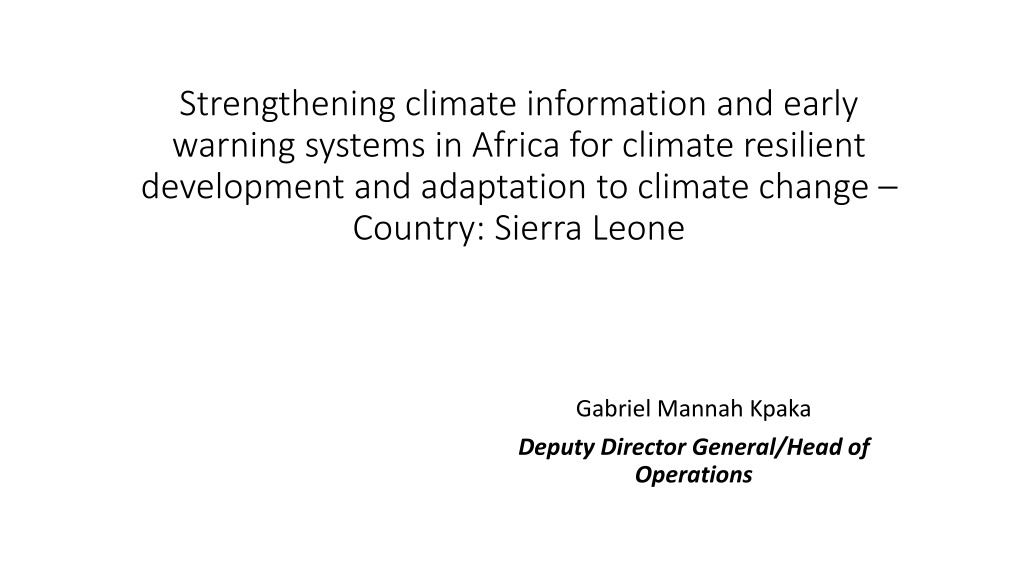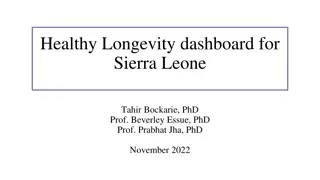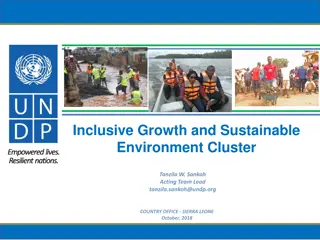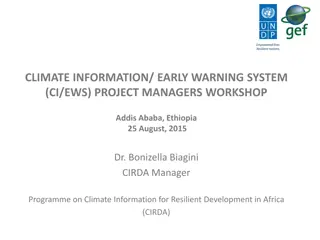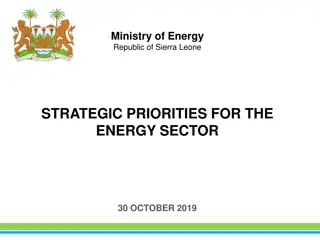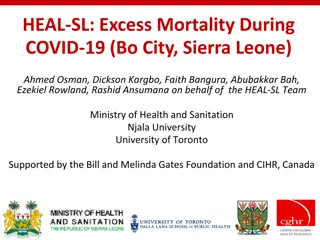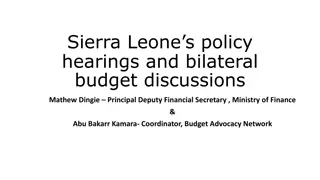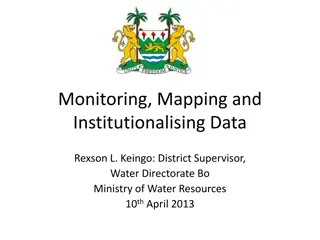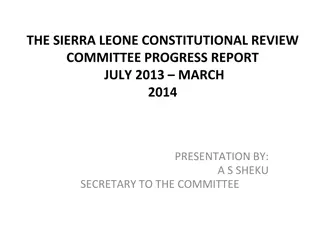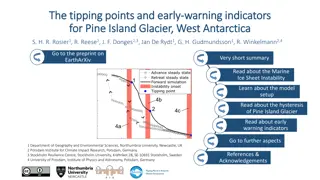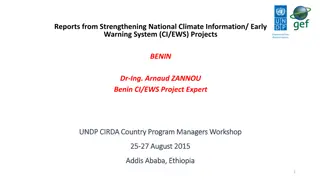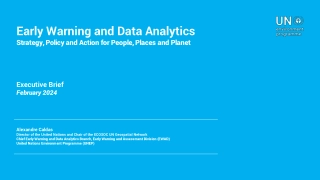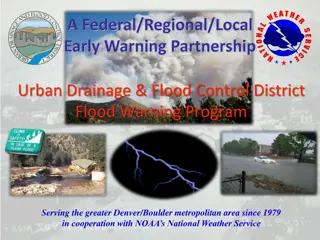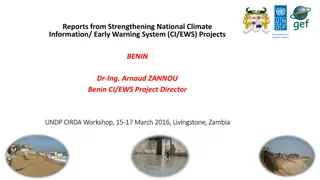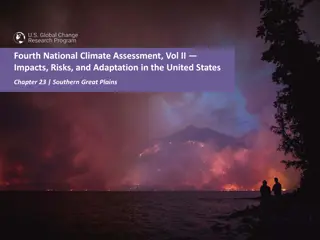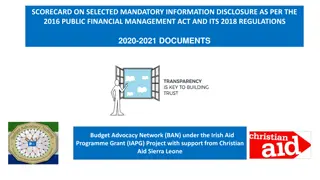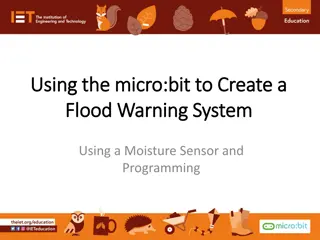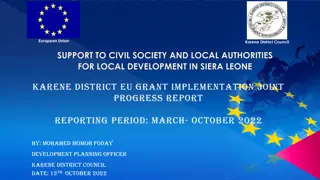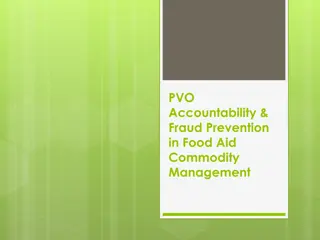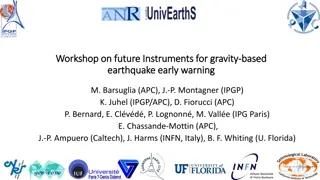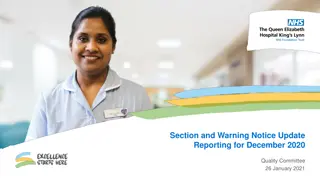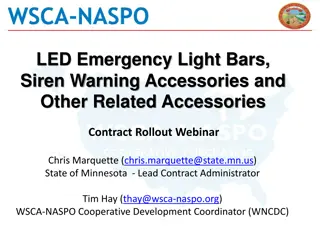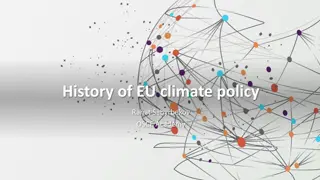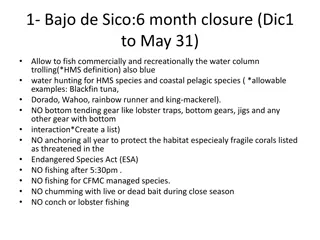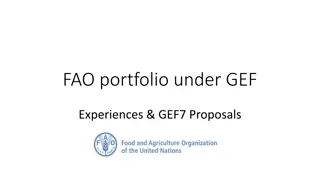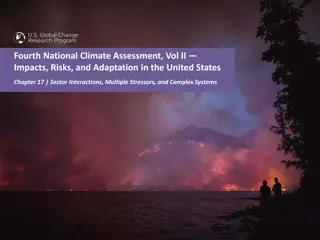Strengthening Climate Information and Early Warning Systems in Sierra Leone
Sierra Leone faces increasing climate-related hazards such as droughts, floods, and severe storms, impacting vital sectors like agriculture and infrastructure. This project aims to enhance the country's hydro-meteorological services, improve climate information delivery, and strengthen early warning systems to build resilience to climate change.
Download Presentation

Please find below an Image/Link to download the presentation.
The content on the website is provided AS IS for your information and personal use only. It may not be sold, licensed, or shared on other websites without obtaining consent from the author. Download presentation by click this link. If you encounter any issues during the download, it is possible that the publisher has removed the file from their server.
E N D
Presentation Transcript
Strengthening climate information and early warning systems in Africa for climate resilient development and adaptation to climate change Country: Sierra Leone Gabriel Mannah Kpaka Deputy Director General/Head of Operations
OUTLINE Country Scenario Network of Weather stations Project Overview Proposed Project Operational structure Project outputs 1 and 2
Country Senario Sierra Leone is particularly vulnerable to: the increasing frequency and severity of droughts, floods and severe storms Their impacts on sectors such as agriculture, fisheries, as well as infrastructure and hydro- electric power production had been severe. Such climate related hazards are having increasingly adverse effects on the country and future climate change is likely to further exacerbate the situation.
Weather Station: Past and Present Station Type Past (Before the War) Before the Project Currently Manned 12 2 3 Synoptic 16 5 9+5 Agromet 32 0 8 (IFAD) Rainfall station 110 0 5 (WMO) Upper Air Station 2 0 0 Radar 1 0 0
Project overview enhance the capacity of hydro-meteorological services and networks to predict climatic events and associated risks develop a more effective and targeted delivery of climate informationincluding early warnings ( Issuing warning and dissemination) Support improved and timely responses to forecast climate-related risks. Capacity development to effectively predict future climate events; Enhance a national framework and environmental databases to assess and integrate climate change risks into sectoral and development policies;
PROJECT OUTPUTS ( 1&2) OUTCOME 1. Enhanced capacity of national hydro-meteorological (NHMS) institutions to monitor extreme weather and produce sector tailored weather forecasting OUTCOME 2.Efficient and effective use of hydro-meteorological information for generating early warnings and support long-term development plans
OUTPUT 1 Components Output 1.1: 12 river gauges, 2 water level (limnimetric scale), 6 groundwater data logger, 2 signal counter rotations for hydrological monitoring are installed in partnership with SLMD to complement watershed management networks of Guma Valley, Bumbuna Watershed and The Ministry of Water Resources (MWR). (The Ministry of Water Resources (MWR)) Results 13 automatic hydrological monitoring stations 15 groundwater monitoring stations
Output 1 component Output 1.2: 38 rainfall gauges, 8 synoptic, 8 Agrometeorological/climatological automatic weather stations, to support the establishment of an integrated weather monitoring network. (Sierra Leone Meteorological Department-SLMD) Results 9 Synoptic AWS 1 Manual Station These stations emits 10 days forecast
Output 1 component Output 1.3: Forecasting meteorological tools, software, infrastructure facilities and specialized training are made available to run SYNERGIE, & AMESD systems to strengthen the capacity of SLMD to produce improved and sector tailored weather forecasts. (Sierra Leone Meteorological Department SLMD) Results Partnership between SLMD and the MAFFS (Food and Nutrition Early Warning Platform) for collaboration in AMESD-PUMA MESA e-station.
Output 1 component Output 1.4: A total of 6 Meteorologists, 16 Meteorological Technicians, 4 Forecasting Superintendent Officers 20 Specialist Superintendent Officers are trained to support EWS data handling and forecasting operations. (Sierra Leone Meteorological Department-SLMD and the University of Sierra Leone - Fourah Bay College) Results 2 Meteorologist trained at MSc level in Reading 7 Meteorological technicians trained in Nigeria 5 hydrologist trained in Niger In-service training on-going
Output 1 component Output 1.5: A Communications network is established for SLMD and ONS-Disaster Management Department to support EWS warning and dissemination mechanism. (ONS-Disaster Management Department and Sierra Leone Meteorological Department-SLMD) Results Communication network between SLMD and the ONS- Disaster Management Department and all DM Committee Members including Directorate of Water Resources established (CIDMEWS); SLMET website
OUTPUT 2 OUTCOME 2: Efficient and effective use of hydro-meteorological information for generating early warnings and support long-term development plans Results 10 days forecast generated from the 8 AWS The installation of the hydrological monitoring stations is ongoing
Gaps needs for hydro-meteorological monitoring to support warning of floods Procure and install more weather stations countrywide ( Marine, Agromet, Upper Air station and Synoptic Weather station) Procure and install Radar Procure and operationalize a mobile AWS for sensor s field calibration, integrating recently installed and existing AWS and interfacing to central data collection & storage system; Centralize data collection & storage systems; Forecasting meteorological tools, software, infrastructure facilities and specialized training: workstations to support downscale of regional and international forecast products for sector tailored forecasting;
.GAP.....cont Procure and install a Television and Radio Weather Broadcast equipment for forecast dissemination; Efficient and effective use of hydro-meteorological information for generating early warnings and support long-term development plans
WAY FORWARD PHASE 2= Building on the SCIEW project
THE END gabrielkpaka@gmail.com
